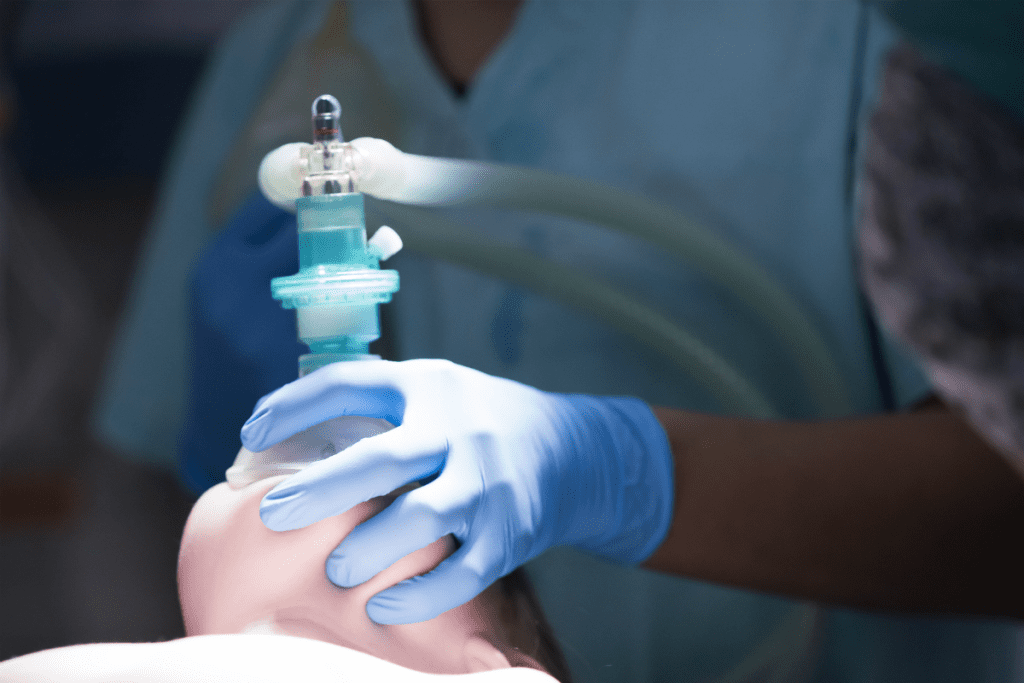Last Updated on November 14, 2025 by
Preparing a child for general anesthesia is key to their safety and comfort during medical procedures. At LivHospital, we know how important it is to prepare well and understand anesthesia what is so we can provide top-notch healthcare and support to families.
We help you with the important steps to get your child ready. This lessens anxiety and lowers the risk of problems. You’ll learn how anesthesia is administered and what to expect on surgery day.

By using our detailed guide, you can make sure your child gets the best care. Our goal is to offer international healthcare standards. We focus on safety and ethics in our care.

General anesthesia is a deep sedation that helps kids feel comfortable during surgery. We make sure to explain this to parents at our institution.
Anesthesia uses medicines that affect the brain and nervous system. This makes the child unconscious and pain-free. There are many types of anesthesia, and knowing about them can ease parents’ worries.
The science of general anesthesia is complex. We pick safe anesthetic agents for kids, considering their age, weight, and health history.
There are several types of anesthesia, such as inhalational agents and intravenous medications. For kids, the choice depends on the surgery and the child’s needs.

Anesthesia can be given in different ways to kids. It can be through an anesthesiologist mask or intravenous routes. The method depends on the child’s condition and the surgery.
For inhalation anesthesia, an anesthesiologist uses a gas. Our skilled anesthesiologists watch the child’s vital signs closely. They adjust the anesthesia to keep the child safe and comfortable.
At our hospital, we do a thorough pre-anesthetic check, especially for kids with health issues. This careful planning helps reduce risks and ensures the best results.
At LivHospital, we stress that getting ready right is key for your child’s safety and happiness with anesthesia. Making sure your child is ready for anesthesia helps lower their stress and cuts down on risks. This makes the surgery smoother and more likely to succeed.
Getting ready properly helps a lot in making your child less anxious. When kids know what’s going to happen, they feel less scared. We use simple words and child life specialists to help them understand.
Also, getting ready right helps avoid problems. By following rules like not eating before surgery, you keep your child safe. Knowing how many hours before surgery your child can eat is key to avoiding anesthesia problems.
Research shows that getting ready well can greatly improve results for kids under anesthesia. It lowers stress and risks, making surgery better. At LivHospital, we’ve seen how good preparation helps our young patients.
We focus on the importance of getting ready right and supporting parents fully. Our team helps you through every step, from the start to after the surgery. We want the best for your child.
Before your child gets general anesthesia, a detailed check-up is key for their safety. At LivHospital, we know a full medical check before anesthesia is vital. This step helps us spot and plan for any possible problems.
We need to know your child’s full medical history to assess anesthesia risks. This includes any past surgeries, allergies, and health issues. A physical exam also checks your child’s health and body functions.
Key components of the medical history include:
Children with asthma or obesity need extra care before anesthesia. Asthma can change how anesthesia works, and obesity raises respiratory risks. We carefully plan for these conditions during surgery.
For children with asthma, we:
Recent respiratory infections up the ante for respiratory problems during surgery in kids. We look into any recent infections and their impact on your child’s health. This helps us tailor the anesthesia and surgery to lower risks.
Knowing the risks and taking steps to prevent them is crucial for your child’s safety. A thorough pre-anesthetic check-up lets us spot and plan for any issues early.
To keep your child safe during anesthesia, it’s important to follow fasting rules before surgery. Fasting before surgery is key to preventing aspiration and other issues. At LivHospital, we guide parents on fasting to keep their child safe.
Stop solid food at least 8 hours before surgery. This includes meals, snacks, and even small foods like crackers. An empty stomach is crucial for your child’s safety during surgery. Check the American Society of Anesthesiologists’ guidelines for the latest fasting rules.
Infants and young children should stop milk or formula 4-6 hours before surgery. The exact time depends on the child’s age and the type of milk or formula. Always follow your healthcare provider’s specific instructions.
Clear liquids like water, clear broth, or sports drinks can be had up to 2 hours before anesthesia. It’s important to know what clear liquids are and avoid those with pulp. This rule helps keep your child’s stomach empty while allowing hydration.
Following these fasting guidelines is crucial for your child’s anesthesia preparation. By doing so, you can reduce risks and make the experience smoother for your child. If you have questions or concerns, always contact your healthcare provider.
At LivHospital, we know how crucial psychological prep is for kids before surgery. It can cut down their anxiety by up to 60%. We don’t just focus on medical checks. We also offer psychological support.
One key method is explaining things in a way kids can understand. Clear and simple info helps them grasp what’s happening. We adjust our explanations to fit the child’s age and level of understanding.
Child life specialists are key in getting kids ready for surgery. They offer emotional support and guidance. They use play therapy to help kids deal with the surgery ahead. “Child life specialists are invaluable in helping children navigate the surgical experience,” says Dr. Jane Smith, a pediatric anesthesiologist.
Books, toys, and play therapy help kids get used to the surgical setting. By playing out the surgery, kids feel more at ease. We also suggest parents bring comfort items for their child.
These techniques help a lot in lowering kids’ anxiety before surgery. At LivHospital, we aim to care for both their medical and emotional needs.
“The use of psychological preparation techniques has been shown to reduce preoperative anxiety in children by up to 60%, making the surgical experience less traumatic for them.”
LivHospital Research
Preparing for your child’s surgery day is key to a smooth experience. At LivHospital, we help you get ready with a detailed checklist. This ensures a stress-free day for your child.
When you get to the hospital, make sure you have everything you need. Remember to bring:
Our staff will help you with the check-in process. Arrive at least 2 hours before surgery to fill out paperwork and get ready.
They will also explain what to expect and answer your questions. This ensures you’re informed and comfortable.
Comfort objects can really help your child feel better. You can bring a small comfort object into the operating room. This could be a favourite toy or blanket.
After the surgery, your child can keep their comfort object with them. Remember, after anesthesia, it’s important to follow our advice on when they can drink and eat. This is usually discussed before surgery.
After anesthesia, it’s key to watch over your child closely. At LivHospital, we help you through this important time. We make sure your child is safe and comfortable.
Children might feel sleepy, nauseous, or vomit after anesthesia. These feelings usually go away with the right care. Knowing about these signs helps you support your child better.
Common side effects may include:
Managing pain well in the first 24 hours is key. We suggest using pain meds and comfort methods like rocking or music. These can help your child feel better.
Tips for managing pain and discomfort:
How long it takes for your child to feel normal again depends on the surgery and their health. We usually tell parents to keep their child quiet for 24 to 48 hours. Then, they can start doing normal things again when they feel up to it.
Guidelines for resuming activities:
At LivHospital, we know how important it is to prepare your child for general anesthesia. By following the steps in this article, you can help your child feel less anxious. It’s also key to understand the different types of anesthesia, like the anesthesiologist mask.
We’ve shown you how to get your child ready, from the medical check before surgery to recovery after. Being informed and prepared helps your child through this tough time. Our goal is to offer top-notch healthcare and support for international patients.
Together with our skilled medical team, we aim to give your child the best care. We’re committed to making their surgery safe and successful.
Anesthesia can slow down bowel movements, which might cause constipation. But this effect is usually short-lived and goes away once the anesthesia wears off.
Anesthesia can be given in different ways, such as through inhalation, intravenous injection, or a mix of both. The choice depends on the procedure, the patient’s health history, and the anesthesiologist’s expertise.
It’s best to follow the fasting instructions given by your healthcare provider or anesthesiologist. Clear liquids are usually okay up to 2 hours before the procedure. Always check with your healthcare team.
There are many types of anesthesia, like general, regional, local, and sedation. The choice depends on the procedure, the patient’s health, and the anesthesiologist’s decision.
Eating before surgery can lead to aspiration, where food or liquid goes into the lungs. Fasting before surgery reduces this risk and makes the anesthetic safer.
The time to start drinking again after anesthesia varies. It depends on the procedure and the individual’s recovery. Clear liquids are introduced slowly, starting with small amounts, when the patient is fully awake and can swallow.
The fasting time before anesthesia changes based on the food type, age, and procedure. Solid food is stopped at least 8 hours before surgery. Clear liquids are allowed up to 2 hours before.
An anesthesiologist is a doctor who specializes in anesthesia and pain management during surgery. They watch the patient’s vital signs and adjust the anesthesia as needed for a safe and comfortable experience.
Yes, bringing a comfort object, like a favourite toy or blanket, can offer emotional support during surgery. Check with your healthcare provider for any specific guidelines.
Subscribe to our e-newsletter to stay informed about the latest innovations in the world of health and exclusive offers!